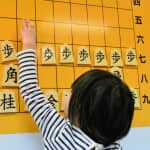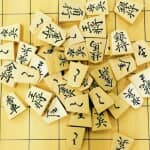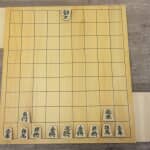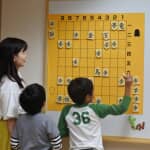Shogi 17 May 2019
Bible of Handicap Game –10 Pieces Dropped–
Koma Ochi refers to a handicap Shogi game. When players play a Koma Ochi game, a stronger player drops his/her own piece/pieces. The number of dropped pieces depends on the difference in skills. The bigger the difference is, the more pieces the player drops. Originally, Koma Ochi was introduced to make a game more fun eliminating the skills gap. Learning Koma Ochi is also very effective to understand Shogi.
We have created a series of articles, which is named “Bible of Handicap Game”. There are several types of Koma Ochi differed by the number of dropped pieces, 10 pieces, 9 pieces, etc. Each article deals with one type and provides you the specific goal you need to reach through learning the Koma Ochi type.
You can gain more from what you’ve learned when you apply the knowledge in a real situation, keeping the goal in your mind.
Bible of Handicap Game –10 Pieces Dropped–
Today’s learning aim is to understand what a 10-piece handicap is. Previously, you learned a 10-piece handicap without Fu (Pawn). Unlike the previous situation, this time, you have nine pieces of Fu (Pawn) on the front lines of both players’ camps. The important point here is you need to move Fu (Pawn) efficiently to move pieces other than Fu (Pawn) which are placed under a line of Fu (Pawn).
Goal to Be Achieved through Learning a 10-Piece Handicap
Make a path for Kaku (Bishop) and move Fu (Pawn) ahead of Hisha (Rook).
Break an opponent’s camp from the space where Gyoku (King) doesn’t exist.
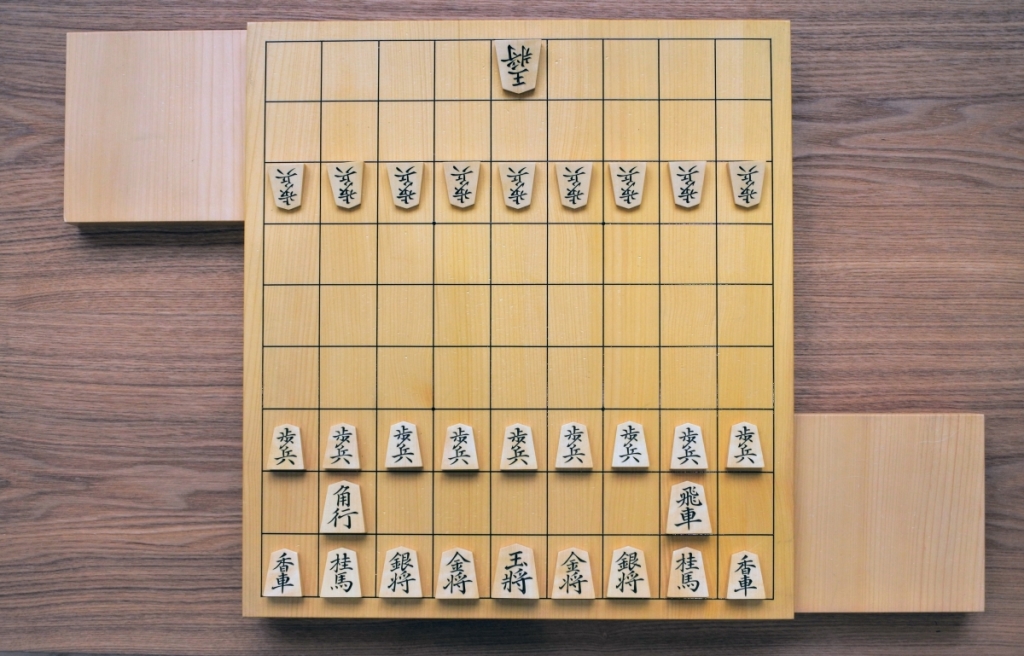
10-Piece Handicap
As you’ve already learned in the previous article, 10-piece Handicap without Fu (Pawn), when you are aiming to capture an opponent’s Gyoku (King), it is crucial to make major pieces promoted.
If there is no Fu (Pawn), you can promote major pieces even on the first move. On the contrary, when you have pieces of Fu (Pawn), things are not that easy. In order to promote pieces under the condition of a 10-piece handicap, you need to do preparation beforehand.
Make a Way for Kaku (Bishop)
When you play an even game which doesn’t have a handicap, the most basic first move is to move Fu (Pawn), P-7f or P-2f. P-2f is for Ibisha style.
Why the first move should be to move Fu (Pawn), P-7f? That is because as your advance preparation, you need to create a situation in which reaching power of your major pieces impacts an opponent’s camp.
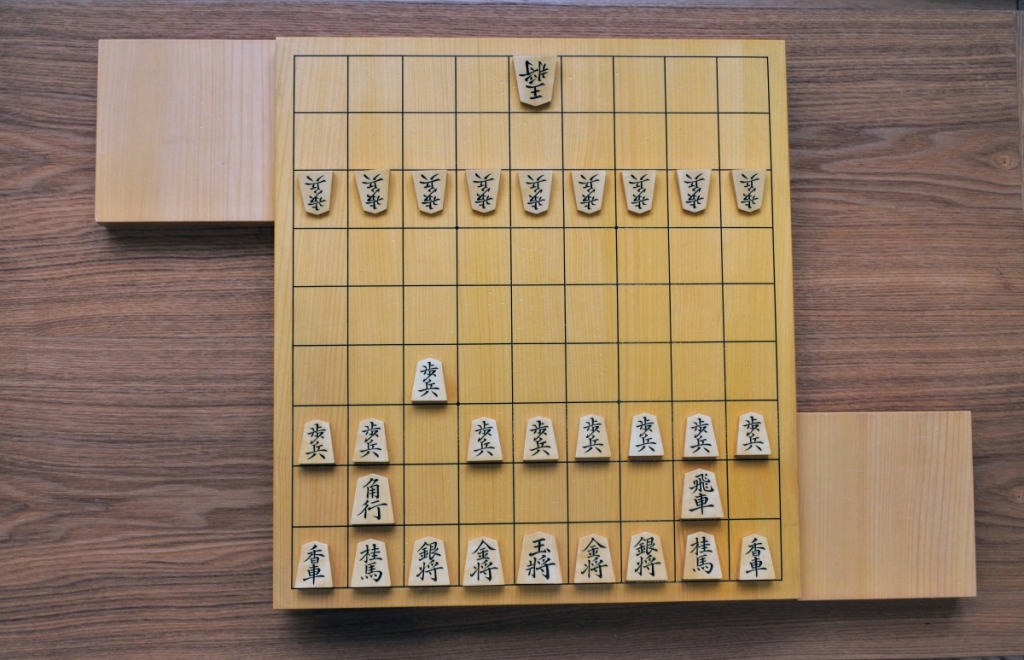
What if you first move Fu (Pawn), P-7f, shown in the above picture? Your Kaku (Bishop) suddenly impacts your opponent’s camp with its reaching power.
You move a piece placed on the Kaku’s (Bishop’s) path and subsequently reaching power of the Kaku (Bishop) covers your opponent’s camp. This is the move named “making a way for a Kaku (Bishop)”, Kakumichi o akeru, which is one of Shogi terms.
There is another Shogi term, Thomi no Kaku, which means farseeing Kaku (Bishop). Making your Kaku’s (Bishop’s) reaching power cover your opponent’s camp widely from a distance, you can prepare for its promotion beforehand and give strong threat with its reaching power. It sounds like you have a sniper, doesn’t it?
By the way, for children who have just learned Shogi, it seems rather easy to make Kaku’s (Bishop’s) reaching power cover their opponent’s camp. Meanwhile, they are likely not to notice the existence of an enemy’s sniper.
Because there is no Kaku (Bishop) for the first player in a game with a 10-piece handicap, children won’t have this issue. They need to take special care to play an even game.
Move Fu (Pawn) ahead of Hisha (Rook)
Let’s move on the next topic, which is about a move, P-2f. P-2f tells you that Fu (Pawn) moved to the square of 2f. As we learned, P-7f is done as a preparation for Kaku (Bishop) to be promoted. P-2f is for Hisha (Rook).
As I mentioned before, preparation for a promotion is what you do to make reaching power cover an opponent’s camp. When you want to have Hisha (Rook) reach an opponent’s camp with its reaching power, you need more steps than when you do with Kaku (Bishop).
Hisha (Rook) moves any number of squares along the rank and file, but only horizontally and vertically. Because of the characteristic of Hisha’s (Rook’s) moves, you have to move Fu (Pawn) forward, P-2e and P-2d. As you notice, when the Fu (Pawn) reaches the square of 2d, it faces the opponent’s Fu (Pawn). If you won’t do anything, your Fu (Pawn) will be taken.
Children easily notice this risk, which their Fu (Pawn) on the square of 2d will be captured, and they hesitate to keep moving the Fu (Pawn) from 2e to 2d. Now, you need courage to keep moving Fu (Pawn) to the square of 2d.

Shogi beginner children often find it difficult to exchange pieces with their opponent. Here, even if the Fu (Pawn) on the 2d square is taken by the Fu (Pawn) on the 2c, your Hisha (Rook) is waiting to take it back.
The outcome won’t be a bad one, because both you and an opponent will gain one piece of Fu (Pawn), respectively. You will, actually, get the upper hand. You moved an opponent’s Fu (Pawn) which had blocked a Hisha’s (Rook’s) path and completed preparation for Hisha (Rook) to be promoted.
You keep Fu (Pawn) ahead of Hisha (Rook) moving forward as preparation for Hisha’s (Rook’s) promotion and this is termed Hishasaki no Fu o tsuku in Japanese.
In the above case, I moved Fu (Pawn) on the second file. When you play a game with Furibisha, you move Hisha (Rook) to somewhere to the left and move Fu (Pawn) placed ahead of the position where Hisha (Rook) moved to.
Break an Opponent’s Camp from Files without Gyoku (King)
Once you finish exchanging pieces of Fu (Pawn), you may be tempted to run through your opponent’s camp and to promote Hisha (Rook). But, things are more complicated than what they look like.
Watching how your major pieces move, your opponent moves Gyoku (King), K-4b and K-3b as protection. If you promote the Hisha (Rook), R-2c+, the piece will be captured by Gyoku (King).
Because it is not safe to keep a piece of yours in the area where there are opponent’ pieces, move your piece backward. In Shogi terms, you use a word, “pull” to express moving a piece backward. In this case, the safe area is the middle rank of this board. For your information, it is named as Ukibisha, or lifted Hisha (Rook), to form the structure of pieces placing Hisha (Rook) on the middle rank.
Even though you’ve pulled Hisha (Rook), you have to make it enter an opponent’s camp to get promoted. Where do you think you would attack when you are aiming to break through your opponent’s camp? It would be the place with the weakest defence, wouldn’t it?
When you play a game with a 10-piece handicap, you should pay attention to Gyoku (King) the most. In other words, the place away from Gyoku (King) is the one with the weakest defence, which means the best place for attacking.

The above picture shows the situation in which Gyoku (King) moves to the right and the files with weak defence are from the 6th to 9th. You may want to attack from those files.
Build Up Skills
You’ve already learned important three points; to make a way for Kaku (Bishop), to move Fu (Pawn) ahead of Hisha (Rook), and to run through an opponent’s camp from files without Gyoku (King). These three points are good enough to play a game with a 10-piece handicap.
Now, let’s build up your skills. You might want to aim at the square of 3c based on the number of pieces.
Basically, Gyoku (King) moves to the right from its initial position.
In the above explanation, I moved Fu (Pawn) ahead of Hisha (Rook), exchanged pieces, and moved Hisha (Rook) to prepare for attacking from the files without Gyoku (King).
Here, after exchanging pieces, keep Hisha (Rook) on the file where Gyoku (King) is also positioned. You’ve made a way for Kaku (Bishop). Now both your Hisha (Rook) and Kaku (Bishop) are acting on the 3c square with reaching power. This is a very important point!
You have two pieces whose reaching power covers the 3c square, Hisha (Rook) and Kaku (Bishop). On the other hand, your opponent has one, Gyoku (King).

As just described, you name it “Number-based attack”, Kazu no Seme, to have a bigger number of pieces whose reaching power covers a certain square than that of an opponent. Gaining an advantage in a number of attacking pieces to a particular square, 3c, you can break through the targeted square of opponent’s camp with Kaku (Bishop), ▲B-3c+.
Review
When you play a game with a 10-piece handicap:
1. Make a way for Kaku (Bishop)
2. Move Fu (Pawn) ahead of Hisha (Rook)
3. Run through an opponent’s camp from files without Gyoku (King)
4. Use a number-based attack
Keep these four points in your mind to accomplish the goal of today’s lesson. Let’s review the way to take an opponent’s Gyoku (King) in the previous lesson, Bible of Handicap Game –10 Pieces Dropped, without Fu (Pawn)–.
The next article is “Bible of Handicap Game –9 Pieces Dropped–”.
